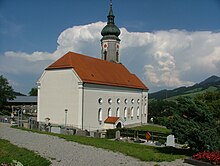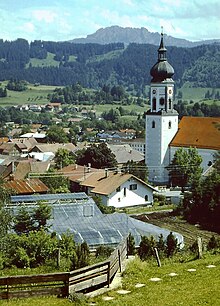Ortisei (Wertach)
The Catholic parish church of St. Ulrich in Wertach , Oberallgäu district in the Bavarian administrative district of Swabia , is essentially a baroque building with an older tower and largely renewed furnishings from 1894/95.
Early history
According to a legend, St. Ulrich is said to have consecrated a church in Wertach on a trip to the Allgäu. The parish was first mentioned in writing on June 11, 1331, when Heinrich von Rötenberg bestowed the patronage and church law of Wertach on the Stams Cistercian monastery in Tyrol. The plague epidemic (1511) and fires (February 21, 1530 and April 30, 1569) hampered the town's economic boom. On June 6, 1605, another fire destroyed 140 of the 147 houses, the rectory and the church. On May 25, 1632, the church was set on fire by Swedish soldiers. The Gothic substructure of the tower has been preserved to this day.
Pilgrimage and church building from 1683
A very lively pilgrimage to Wertach has been mentioned since 1670, which made Saint Joseph the second patron of the church. The Joseph Brotherhood was founded on July 20, 1677 and soon numbered over 20,000 members from the Allgäu, Tyrol, Italy and Switzerland. With their financial means from 1683 to 1685 under the direction of master builder Caspar Feichtmayr, the new church could be built. The house of God was no longer in the village, as some citizens would prefer, but on a hill, because according to legend, angels are said to have brought what was set up in the village over and over again overnight. The consecration took place on July 24, 1696. Remodeling took place in 1755/56 and in the second half of the 19th century.
Fire of 1893 and reconstruction
On April 16, 1893, the once baroque parish church burned down. The lower part of the pulpit with the four golden evangelist symbols on the pulpit basket ( Johann Georg Hagenauer , around 1700) have been preserved. The reconstruction according to plans by Hugo von Höfl took place in 1894/95. The ceiling frescoes were created by Bonifaz Locher from Munich in 1895 . In 1979 the church was extended to the depth of the gallery and restored.
Altars
A Marian altar is documented in 1487, three altars were present in 1593. During the fire in 1893, only the tabernacle by Johann Richard Eberhard , made in 1769/70, gleaming in rich gold jewelry, remained of the baroque high altar . The two side altars could be saved.
The large painting on the high altar shows Jesus, Mary and Joseph on the way to the temple, while the diocese saints Ulrich and Afra are shown in the upper altarpiece. The side altars still have the altarpieces saved from the fire in 1893, which were created in 1833 by the local painter Franz Sales Lochihler: on the left, St. Family with the Johannesknaben and St. Michael, on the right the corpse of Jesus removed from the cross in his mother's lap. Above the right side altar is a representation of St. Brother Konrad von Parzham , above the left side altar is the old pilgrimage picture of St. Josef by the Constance painter Christoph Storer (1611–1671).
Frescoes
The frescoes were created by the Munich painter Bonifaz Locher in 1895. The ceiling painting in the chancel depicts the Ascension of Christ. Motifs of the vaulted areas in the nave are the Annunciation, the birth of Christ, Jesus in the temple, the handing over of the keys to Peter and the crucifixion.
particularities
Special features of art history are the expressive figures of the apostles, which Ignaz Erdt created from Vorderreute around 1700, and the Ulrichs reliquary (1765).
organ
The organ was created in 1983 by organ builder Schmid, Kaufbeuren. It has 2278 pipes, spread over 34 sounding registers.
literature
- Michael Petzet : The art monuments of Bavaria , VII. Swabia, Volume 8: District Sonthofen . 1964, ISBN 3-486-41921-8
- Klaus Wankmiller: When thousands of pilgrims came. In: Catholic Sunday newspaper, Diocese of Augsburg. 14./15. March 2020, page 29
Web links
- The parish church on the parish homepage , accessed on March 29, 2020
Coordinates: 47 ° 36 ′ 13.3 " N , 10 ° 24 ′ 32" E



